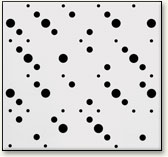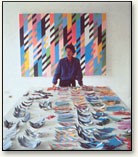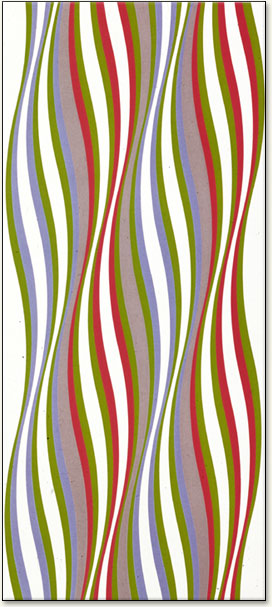Bridget Riley and Op Art

White Disks, Bridget Riley, 1964. She wrote, “The uncertainties of a drawn structure increase when it is composed of similar, repeated elements. Because they are small and compacted, these elements begin to fuse while they are easy to separate when they are big.”
Bridget Riley (1931) is a well-known British artist celebrated since the mid-1960s for her distinctive, optically vibrant paintings, called “Op Art.” She explores optical phenomena and juxtaposes color either by using a chromatic technique of identifiable hues or by selecting achromatic colors (black, white or gray). In doing so, her work appears to flicker, pulsate and move, encouraging the viewer’s visual tension. Riley’s vibrant optical pattern paintings, which she painted in the 1960s, were hugely popular and become a hallmark of the period. As your eyes explore the picture to the left, can you continue to see momentary afterimages (white dots) that cause a slight flickering effect?

Bridget Riley analyzing color combinations.
Riley spent two years copying Seurat’s painting, Bridge of Courbevoie, to learn about his painting technique and his use of complementary colors. She describes the process as “being a revelation to her” with regard to color. Soon after, in 1966, Riley begins to use color to achieve new optical effects. By juxtaposing lines of complementary pure colors she can affect the perceived brightness of the individual colors.
Riley works meticulously, carefully mixing her colors to achieve the exact hue and intensity she desires. She explores color interaction first in small gouache color studies, then moving to full-size paper-ad-gouache designs (as in the photo at right). The large-scale canvases are then marked up and painted entirely by hand — first in acrylics, then in oil.

Dominance Portfolio, Blue, Bridget Riley, 1977.
Riley is interested in visual effects, commenting:
The eye can travel over the surface in a way parallel to the way it moves over nature. It should feel caressed and soothed, experience frictions and ruptures, glide and drift. One moment, there will be nothing to look at and the next second the canvas seems to refill, to be crowded with visual events.
She also continues to work in black, white and gray, although gray is largely an illusion of overlapping circles. In Riley’s large mural, Composition with Circles (1998), the disks construct a volatile and dynamic space of overlapping transparent circles. While stressing the importance of “clarity of color, order of mind…no gratuitous brushwork,” Riley also recognizes the relationship between music and painting, as did artists such as Kandinsky.
You can listen to Riley discussing the development of her painting by clicking the audio play button, above.